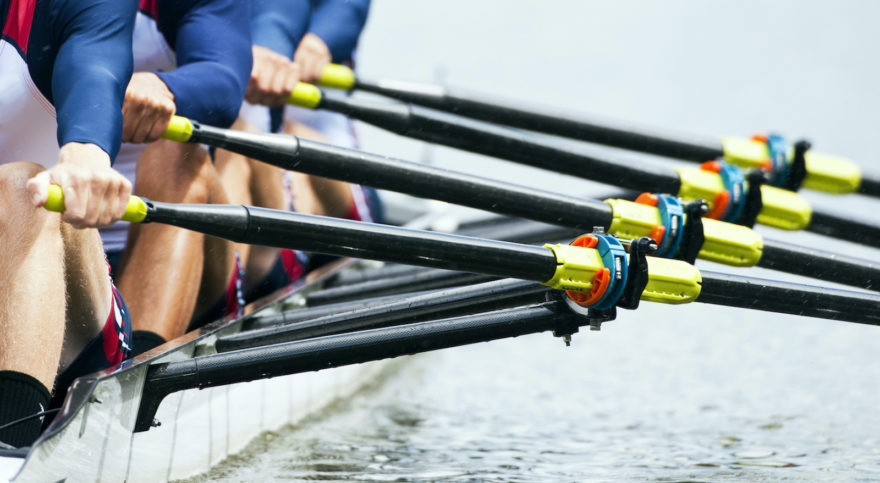- Blog
- > Athletic Recruiting
How to Get Recruited for Crew in College?
- Dr. Rachel Rubin
- | November 20, 2024

What to Know About Crew Recruitment
The first thing to know about rowing in college is that you definitely do not need to be an official recruit to do so. Both men and women’s collegiate crew teams are big, with 60 or more members at any given time. As such, there are generally lots of walk-ons in addition to a handful of recruited players. In general, crew coaches will tell you: if you want to row in college, there will be plenty of opportunities to do so, recruit or not!
Another thing to be aware of in collegiate rowing is that the line between club and varsity is much blurrier than in other sports. Many collegiate club crew teams have the same support, resources, and competition schedule as an official varsity team. So, if the schools you’re excited about only have club crew, don’t fret! Once you do some research, you may very well find that it’s as competitive and well-funded a team as any varsity program.
When it comes to recruitment specifically, coaches care about a range of physical fitness metrics, experience, and technique, but the first thing anyone will ask you about regarding crew recruitment is your 2k erg time. Knowing and understanding that number will be crucial to figuring out whether you’d be a competitive recruit, the strength of programs to which you could potentially be recruited, and what to tell coaches when they inevitably ask about it.
Another thing to consider about collegiate rowing is something you already know: that crew is a profoundly time-consuming sport and being on a college team is a big commitment. Being a student-athlete in college is a great way to have a community and stay in shape, but it’s also important to think about what you want your life at college to look like. Are you willing to make the time commitment to rowing during your undergraduate career?
Finally, in crew as in all athletic recruitment, it’s important to be in frequent and open communication with your current coach to figure out how to proceed. Recruitment is about self-presentation and effective networking; you can’t sit back and assume a college coach will contact you. Working with your coach to identify your top prospects and to improve your technique and fitness is essential to becoming a successful crew recruit.
How to Maximize Your Recruitment Chances
The things that every college coach is seeking in a crew recruit are: strong academics, long-term experience on your high school or club team, good technique, and advantageous physical attributes like height and wingspan. However, those are just the basics to begin the process. To really increase your chances, keep this advice in mind:
Get Your Erg Times Down
Although you row alongside your teammates as a crew member, your individual strength and abilities are paramount. For that reason, if there’s one variable a crew coach cares about above all else, it’s your 2k erg time—the time it takes you to row two kilometers on the erg. Knowing that number is the first step to getting recruited for crew.
That said, there is no magical number above which you have no shot and below which you’re guaranteed to become a recruit. Rather, ideal erg times vary by division and school, as well as by gender and category. For women, an erg time under 7:30 is likely to attract attention from top programs; for men, a time under 6:30 will generally perk up ears.
Nevertheless, the requisite erg time will depend on the types of schools at which you’re hoping to be recruited and how competitive their teams are. Women with erg times in the 7:40-7:50 range certainly have a shot at D3 and top club programs, as do men in the 6:40-6:50 range. However, for the top D1 programs, women will need to be under 7:20, and men under 6:20, even 6:15.
When all is said and done, if you’re hoping to be recruited for crew, the best thing you can do to increase your chances is get that erg time down. Lower is always better, and having a strong time in your hand by the point when you start contacting coaches in sophomore or junior year will increase your chances of success.
Ask Insightful Questions
As you develop relationships with coaches, asking the right questions becomes just as important as sharing your achievements. Regularly updating coaches with your latest erg times, academic progress, and videos of your technique is essential, but thoughtful questions can set you apart as a recruit who is both engaged and strategic.
Think of each conversation as a chance to both impress and learn. Inquire about the team’s training approach, the role of freshmen on the roster, or the academic-athletic balance at their school. These well-considered questions not only demonstrate your genuine interest but also provide valuable insights to help you determine if the program aligns with your goals.
Keep Your Grades Up
Finally, it’s crucially important that throughout the recruitment process, you maintain a strong academic performance at school. Having the skills and attitude to impress coaches matters a lot, but if they can’t make a compelling case to the admissions office for you as an academic student, your chances of becoming a crew recruit are slim to none.
Your Path to Collegiate Rowing Success
Before you start the recruitment process for crew, make sure it’s the right path for you. Crew teams are necessarily large, and only the most competitive collegiate teams fill their rosters through recruitment. That means that many high school rowers decide they’d rather walk on at the college of their choice rather than focus solely on recruitment.
However, if you’re certain that recruitment is worth it for you, keeping these general ideas in mind will ensure that the process goes as successfully as possible!


